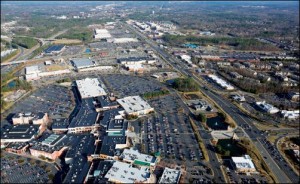by James A. Bacon
The Short Pump area of Henrico County, the largest retail concentration in Central Virginia, is a fascinating test case for the proposition that it’s possible for state and local governments to build their way out of traffic gridlock. My verdict: Henrico has managed to beat the odds so far, but future prospects look bleak.
I focused on the transportation challenges of Short Pump in a cover story published this month in Henrico Monthly. A rural crossroads thirty years ago, Short Pump in Western Henrico County has exploded with development. Ranked by traffic counts, the stretch of West Broad between Interstate 64 and Pouncey Tract is the second busiest non-Interstate road in the entire Richmond region. Given the profusion of stop lights, it may be the most congested. With the Short Pump Town Center and other top-of-the-line retail, Short Pump is a location that Richmonders love to hate. In the immortal words of Yogi Berra, “Nobody goes there anymore. It’s too crowded.”
Henrico County planners and elected officials are acutely aware of the horrendous traffic conditions, and they have responded as suburban governments always have — by laying more asphalt. More than $150 million in state and local dollars have or will be spent between 2011 and 2017 to improve mobility in and around the area. For a while at least, the road projects seemed to be doing the job. After peaking at 69,000 vehicles per day in 2006, traffic counts along West Broad declined to 50,000 vpd by 2012. How much was due to the 2007 recession and how much due to Henrico’s road construction program isn’t clear. But there are indications the decline was only temporary. In 2013, the most recent year for which figures are available, the county spiked back up to 69,000.
Things could get worse. As Smart Growth advocates have long maintained, building or widening roads opens up new acreage for development and enables people to change their driving habits, leading to increased traffic — a phenomenon known as induced demand. Meanwhile, the Board of Supervisors has approved several new development projects that will push development further west toward the Goochland County line, generating even more traffic. That growth comes just as the burst of publicly funded road building is coming to an end. County plans do call for the construction of two roads parallel to West Broad, which could be built largely through developer proffers. The southern route, Three Chopt Road, shows real promise for diverting traffic. But the northern route, Tom Leonard Parkway, would run through Short Pump mall and would encounter expensive natural obstacles; it won’t be built any time soon, and it will be of limited utility if it is.
County officialdom also has awakened to the necessity of shifting land use patterns from the conventional suburban model (low density, segregated land uses, auto-centric design) to walkable urbanism (walkable, mixed-use development that encourages live-work-play). The more people walk to retail or entertainment destinations, the less they’re driving their cars. One major project, West Broad Village, utilized a new zoning construct — Urban Mixed Use — to build an island of walkability. That project has proved to be a commercial success. However, it has done little to curtail traffic congestion. The oasis is just too small, and there are too few destinations for residents to walk to. Cognizant of that shortcoming, county officials are insisting that new development provide pedestrian connectivity to neighboring projects.
That’s the good news. The bad news is that creating islands of walkability won’t bring about the lifestyle changes that need to occur in order to reduce the number of vehicle trips, and the new thinking comes too late to salvage what has been built over the past thirty years. Eventually, after enough time has passed and enough properties have been fully depreciated, developers might tear down and rebuild according to the UMU template. Until then, it’s hard to see the atrocious traffic conditions at Short Pump getting any better, and they may well get worse.



